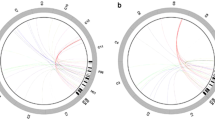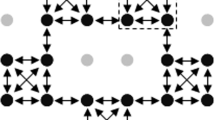Abstract
Since apomixis was first mapped in Paspalum, the absence of recombination that characterizes the related locus appeared to be the most difficult bottleneck to overcome for the dissection of the genetic determinants that control this trait. An approach to break the block of recombination was developed in this genus through an among-species comparative mapping strategy. A new apomictic species, P. procurrens (Q4094) was crossed with a sexual plant of P. simplex and their progeny was classified for reproductive mode with the aid of morphological, embryological and genetic analyses. On this progeny, a set of heterologous rice RFLP markers strictly co-segregating in coupling phase with apomixis was identified. These markers were all located on the telomeric region of the long arm of the chromosome 12 of rice. In spite of the lack of recombination exhibited by the apomixis-linked markers in P. procurrens, a comparative mapping analysis among P. simplex, P. malacophyllum, P. notatum and P. procurrens, allowed us to identify a small group of markers co-segregating with apomixis in all these species. These markers bracketed a chromosome region that likely contains all the genetic determinants of apomictic reproduction in Paspalum. The implications of this new inter-specific approach for overcoming the block of recombination to isolate the genetic determinants of apomixis and gain a better comprehension of genome structure of apomictic chromosome region are discussed.


Similar content being viewed by others
References
Albertini E, Marconi G, Reale L, Barcaccia G, Porceddu A, Ferranti F, Falcinelli M (2005) SERK and APOSTART. Candidate genes for apomixis in Poa pratensis. Plant Physiol 13:2185–2199
Al-Janabi SM, Honeycutt RJ, McClelland M, Sobral BW (1993) A genetic linkage map of Saccharum spontaneum L. Genetics 134:1249–1260
Allard RW (1960) Principles of plant breeding. John Wiley & Sons Inc, New York
Avramova Z, Tikhonov A, SanMiguel P, Jin Y-K, Liu C, Woo S-S, Wing RA, Bennetzen JL (1996) Gene identification in a complex chromosomal continuum by local genomic cross-referencing. Plant J 10:1163–1168
Ayliffe MA, Lawrence GL, Ellis JG, Pryor AJ (1994) Heteroduplex molecules between allelic sequences cause nonparental RAPD bands. Nucleic Acids Res 22:1632–1636
Bennetzen JL, Freeling M (1997) The unified grass genome: synergy in synteny. Genome Res 7:301–306
Bicknell RA, Borst NK, Koltunow AM (2000) Monogenic inheritance of apomixis in two Hieracium species with distinct developmental mechanisms. Heredity 84:228–237
Burton GW (1948) Artificial fog facilitates Paspalum emasculation. J Am Soc Agron 40:281
Cáceres ME, Pupilli F, Quarin CL, Arcioni S (1999) Feulgen-DNA densitometry of embryo sacs permits discrimination between sexual and apomictic plants in Paspalum simplex. Euphytica 110:161–167
Cáceres ME, Matzk F, Busti A, Pupilli F, Arcioni S (2001) Apomixis and sexuality in Paspalum simplex: characterization of the mode of reproduction in segregating progenies by different methods. Sex Plant Reprod 14:201–206
Calderini O, Chang BS, de Jong H, Busti A, Paolocci F, Arcioni S, de Vries SC, Abma-Henkens MHC, Klein Lankhorst RM, Donnison IS, Pupilli F (2006) Molecular cytogenetics and DNA sequence analysis of an apomixis-linked BAC in Paspalum simplex reveal a non pericentromere location and partial microcolinearity with rice. Theor Appl Genet 112:1179–1191
Calderini O, Donnison I, Polegri L, Panara F, Thomas A, Arcioni S, Pupilli F (2010) Partial isolation of the genomic region linked with apomixis in Paspalum simplex. Mol Breed. doi:10.1007/s11032-010-9480-7
Caponio I, Quarín CL (1987) El sistema genetico de Paspalum simplex y de un hibrido interespecifico con Paspalum dilatatum. Kurtziana 19:35–45
Catanach AS, Erasmuson SK, Podivinsky E, Jordan BR, Bicknell R (2006) Deletion mapping of genetic regions associated with apomixis in Hieracium. P Natl Acad Sci USA 103:18650–18655
Chen M, SanMiguel P, de Oliveira AC, Woo S–S, Zhang H, Wing RA, Bennetzen JL (1997) Microcolinearity in sh2-homologous regions of the maize, rice, and sorghum genomes. P Natl Acad Sci USA 94:3431–3435
Chen L, Guan L, Sro M, Hoffmann F, Adachi T (2005) Developmental expression of ASG-1 during gametogenesis in apomictic guinea grass (Panicum maximum). J Plant Physiol 162:1141–1148
Conner JA, Goel S, Gunawan G, Cordonnier-Pratt MM, Johnson VE, Liang C, Wang H, Pratt LH, Mullet JE, DeBarry J, Yang L, Bennetzen JL, Klein PE, Ozias-Akins P (2008) Sequence analysis of bacterial artificial chromosome clones from the apospory-specific genomic region of Pennisetum and Cenchrus. Plant Physiol 147:1396–1411
d′Erfurth I, Jolivet S, Froger N, Catrice O, Novatchkova M, Mercier R (2009) Turning meiosis into mitosis. PLoS Biol 7:e1000124
Espinoza F, Quarin CL (1997) Relación genómica entre citotipos diploides de Paspalum simplex y Paspalum procurrens (Poaceae, Gramineae). Darwiniana 36:59–63
Garcia-Aguilar M, Michaud C, Leblanc O, Grimanelli D (2010) Inactivation of a DNA methylation pathway in maize reproductive organs results in apomixis-like phenotypes. Plant Cell 22:3249–3267
Goel S, Chen Z, Conner JA, Akiyama Y, Hanna WW, Ozias-Akins P (2003) Delineation by fluorescence in situ hybridization of a single hemizygous chromosomal region associated with aposporous embryo sacs formation in Pennisetum squamulatum and Cenchrus ciliaris. Genetics 163:1069–1082
Grimanelli D, Leblanc O, Espinosa E, Perotti E, González de León D, Savidan Y (1998) Non-Mendelian transmission of apomixis in maize-Tripsacum hybrids caused by a transmission ratio distortion. Heredity 80:40–47
Hanna WW, Bashaw EC (1987) Apomixis: its identification and use in plant breeding. Crop Sci 27:1136–1139
Harlan JR, Brooks MH, Borgaonkar DS, de Wet JMJ (1964) Nature and inheritance of apomixis in Botriochloa and Dichanthium. Bot Gaz 125:41–46
Herr JM (1971) A new clearing-squash technique for the study of ovule development in angiosperms. Am J Bot 58:785–790
Hojsgaard D, Schegg E, Valls JFM, Martinez EJ, Quarin CL (2008) Sexuality, apomixis, ploidy levels, and genomic relationships among four Paspalum species of the subgenus Anachyris (Poaceae). Flora 203:535–547
Koltunow AM, Bicknell RA, Chaudhury AM (1995) Apomixis: molecular strategies for the generation of genetically identical seeds without fertilization. Plant Physiol 108:1345–1352
Lander E, Green P, Abrahmson J, Barlow A, Daly M, Lincoln S, Newburg L (1987) MAPMAKER: an interactive computer package for constructing primary genetic linkage maps in experimental and natural populations. Genomics 1:171–181
Lincoln SE, Daley MJ, Lander ES (1992) Constructing genetic maps with MAPMAKER/EXP 3.0. Technical Report, 3rd edn. Whitehead Institute, Cambridge
Liu BH (1998) Statistical genomics: linkage mapping and QTL analysis. CRC Press, Boca Raton
Lyttle TW (1991) Segregation distortes. Annu Rev Genet 25:511–557
Marimuthu MPA, Jolivet S, Ravi M, Pereira L, Davda JN, Cromer L, Wang L, Nogué F, Chan SWL, Siddiqi I, Mercier R (2011) Synthetic clonal reproduction through seeds. Science 331:876
Martelotto LG, Ortiz JPA, Stein J, Espinoza F, Quarin CL, Pessino SC (2007) Genome rearrangements derived from autopolyploidization in Paspalum sp. Plant Sci 172:970–977
Martínez EJ, Urbani MH, Quarin CL, Ortiz JPA (2001) Inheritance of apospory in bahiagrass, Paspalum notatum. Hereditas 135:19–25
Martínez EJ, Ortiz JPA, Hopp HE, Quarin CL (2003) Genetic characterization of apospory in tetraploid Paspalum notatum based on the identification of linked molecular markers. Mol Breed 12:319–327
Martínez EJ, Acuña CA, Hojsgaard DH, Tcach MA, Quarin CL (2007) Segregation for sexual seed production in Paspalum as directed by male gametes of apomictic triploid plants. Ann Bot 100:1239–1247
Nogler GA (1982) How to obtain diploid apomictic Ranunculus auricomus plants not found in the wild state. Bot Helv 92:13–22
Nogler GA (1984a) Gametophytic apomixis. In: Johri BM (ed) Embryology of angiosperms. Springer, Berlin., pp 475–518
Nogler GA (1984b) Genetics of apospory in apomictic Ranunculus auricomus. V. Conclusions. Bot Helv 92:123–411
Noyes RD, Rieseberg LH (2000) Two independent loci control agamospermy (apomixis) in the triploid flowering plant Erigeron annuus. Genetics 155:379–390
Noyes RD, Baker R, Mai B (2007) Mendelian segregation for two-factor apomixis in Erigeron annuus (Asteraceae). Heredity 98:92–98
Olmedo-Monfil V, Durán-Figueroa N, Arteaga-Vázquez M, Demesa-Arévalo E, Autran D, Grimanelli D, Slotkin RK, Martienssen RA, Vielle-Calzada J-P (2010) Control of female gamete formation by a small RNA pathway in Arabidopsis. Nature 464:628–632
Ozias-Akins P, Roche D, Hanna WW (1998) Tight clustering and hemizygosity of apomxis-linked markers in Pennisetum squamulatum implies genetic control of apospory by a divergent locus that may have no allelic form in sexual genotypes. P Natl Acad Sci USA 95:5127–5132
Parisod C, Holderegger R, Brochmann C (2010) Evolutionary consequences of autopolyploidy. New Phytol 186:5–17
Polegri L, Calderini O, Arcioni S, Pupilli F (2010) Specific expression of apomixis-linked alleles revealed by comparative transcriptomic analysis of sexual and apomictic Paspalum simplex Morong flowers. J Exp Bot 61:1869–1883
Pupilli F, Caceres ME, Quarín CL, Arcioni S (1997) Segregation analysis of RFLP markers reveals a tetrasomic inheritance in apomictic Paspalum simplex. Genome 40:822–828
Pupilli F, Lambobarda P, Cáceres ME, Quarin CL, Arcioni S (2001) The chromosome segment related to apomixis in Paspalum simplex is homoeologous to the telomeric region of the long arm of rice chromosome 12. Mol Breed 8:53–61
Pupilli F, Martínez EJ, Busti A, Calderini O, Quarin CL, Arcioni S (2004) Comparative mapping reveals partial conservation of synteny at the apomixis locus in Paspalum spp. Mol Genet Genomics 270:539–548
Quarin CL (1992) The nature of apomixis and its origin in panicoid grasses. Apomixis Newsl 5:8–15
Quarin CL, Espinoza F, Pessino Martínez EJ, SC Bovo OA (2001) A rise of ploidy level induces the expression of apomixis in Paspalum notatum. Sex Plant Reprod 13:243–249
Ravi M, Chan SW (2010) Haploid plants produced by centromere-mediated genome elimination. Nature 464:615–618
Ravi M, Marimuthu MP, Siddiqi I (2008) Gamete formation without meiosis in Arabidopsis. Nature 451:1121–1124
Roche D, Chen Z, Hanna WW, Ozias-Akins P (2001) Non-Mendelian transmission of an apospory-specific genomic region in a reciprocal cross between sexual pearl millet (Pennisetum glaucum) and an apomictic F1 (P. glaucum × P. squamulatum). Sex Plant Reprod 13:217–223
Schallau A, Arzenton F, Johnston AJ, Hähnel U, Koszegi D, Blattner FR, Altschmied L, Haberer G, Barcaccia G, Baumlein H (2010) Identification and genetic analysis of the APOSPORY locus in Hypericum perforatum L. Plant J 62:773–784
Skinner DJ, Baker SC, Meister RJ, Broadhvest J, Schneitz K, Gasser CS (2001) The Arabidopsis HUELLENLOS gene, which is essential for normal ovule development, encodes a mitochondrial ribosomal protein. Plant Cell 13:2719–2730
Southern EM (1975) Detection of specific sequences among DNA fragments separated by gel electrophoresis. J Mol Biol 98:503–517
Stein J, Pessino SC, Martínez EJ, Rodriguez MP, Siena LA, Quarin CL, Ortiz JPA (2007) A genetic map of tetraploid Paspalum notatum Flügge (bahiagrass) based on single-dose molecular markers. Mol Breed 20:153–166
Urbani MH, Quarin CL, Espinoza F, Penteado MIO, Rodrigues IF (2002) Cytogeography and reproduction of the Paspalum simplex polyploid complex. Plant Sys Evol 236:99–105
van Dijk P (2003) Ecological and evolutionary opportunities of apomixis: insights from Taraxacum and Chondrilla. Philos T Roy Soc B 358:1113–1121
Vijverberg K, Van der Hulst RGM, Lindhout P, Van Dijk PJ (2004) A genetic linkage map of the diplosporous chromosomal region in Taraxacum officinale (common dandelion; Asteraceae). Theor Appl Genet 108:725–732
Wu KK, Burnquist W, Sorrells ME, Tew TL, Moore PH, Tanksley SD (1992) The detection and estimation of linkage in polyploids using single-dose restriction fragments. Theor Appl Genet 83:294–300
Acknowledgments
The authors wish to thank Mrs. Florencia Galdeano and Mr. Marco Guaragno for their technical assistance. This work was supported by the Italian Ministero degli Affari Esteri, Direzione Generale per la Promozione e la Cooperazione Culturale (L401/1990) in the frame of the project “Isolation of genetic determinants of apomixis in Paspalum simplex” (bilateral agreement Italy–Argentina, 2006–2007), the Agencia Nacional de Promoción Científica y Tecnológica (ANPCyT), Argentina, PICT N 13578 and PAV 137/3, and the Consejo Nacional de Investigaciones Científicas y Técnicas, Argentina (CONICET), PIP 11220080101378. DH Hojsgaard received a fellowship from CONICET. We thank Dr. T. Sasaki, the Japanese Rice Genome Research Program of the National Institute of Agrobiological Resources (NIAR), and the Institute of the Society of Techno-Innovation in Agriculture, Forestry and Fisheries (STAFF), Tsukuba, Japan, for providing the rice probes. Contribution No. 364 from CNR-IGV Perugia.
Author information
Authors and Affiliations
Corresponding author
Additional information
Communicated by P. Langridge.
Rights and permissions
About this article
Cite this article
Hojsgaard, D.H., Martínez, E.J., Acuña, C.A. et al. A molecular map of the apomixis-control locus in Paspalum procurrens and its comparative analysis with other species of Paspalum . Theor Appl Genet 123, 959–971 (2011). https://doi.org/10.1007/s00122-011-1639-z
Received:
Accepted:
Published:
Issue Date:
DOI: https://doi.org/10.1007/s00122-011-1639-z




